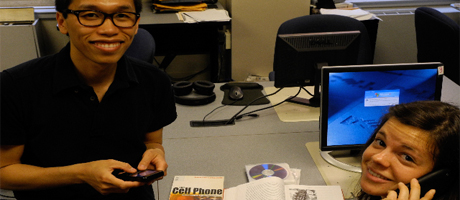Professor of Anthropology Joel Kuipers’ fascination with cell phones extends well beyond texting and the “Words with Friends” smart phone app. Mindful of the estimated 6 billion cell phone subscribers worldwide, Kuipers is interested in how different ethnic groups—specifically, immigrant communities—use mobile phones. Do they use them to stay in touch with friends and family in their home nations? Do cell phones help them organize community events in their new countries?
“Cell phones are not just technology devices,” explained Kuipers. “They are also material objects that have meaning for people, and those meanings vary by communities, not just by individual.”
With a $40,000 grant from the GW-Smithsonian Institution Opportunity Fund, Kuipers is embarking on research to learn how cell phones affect communication within immigrant populations. In partnership with Dr. Joshua Bell, the curator for globalization at the National Museum of Natural History, Kuipers and student researchers Briel Kobak and Trung Le are investigating cell phone use by the Central American immigrant communities in Washington, D.C.’s Mount Pleasant neighborhood and by the Vietnamese population in Falls Church, Va.
“One of the things that I am interested in exploring is different kinds of demographic patterns,” said Kuipers. “It will be interesting to see if the Vietnamese community uses cell phones less to communicate with their homeland and more to coordinate activities here in the U.S. than do the Salvadorans.”
The project looks at cell phone advertisements in the selected area and past cell-phone research. Students in the Discourse Laboratory, housed in Columbian College’s Department of Anthropology, will analyze interviews with immigrants.
“It’s thrilling to conduct field research with Professor Kuipers and put everything I’ve been learning for the past four years into actual practice,” said Kobak, a senior anthropology major.
“This is giving me a lot of hands-on experience in research,” said Le, a graduate student in international development and assistant researcher on the project. “In our field work, we will interview people, review literature, meet with the professors, and write proposals, so there are a lot of things going on.”
Kuipers and Bell intend to invite scholars in the field to participate in wide-ranging workshops, from aesthetics to linguistics and their ecological impacts. The work will culminate with a full-blown exhibit at the National Museum of Natural History.
(In photo, student researchers Briel Kobak, right, and Trung Le)


